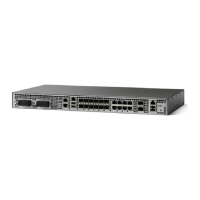27
Cisco IOS XE 3S Release Notes for the Cisco ASR 903 Router
OL-26630-12
Chapter
Caveats in Cisco IOS XE 3.8S Releases
–
With multicast traffic enabled, you configure 24 EFPs and map them to the existing
bridge-domain.
One of the 48 EFPs does not receive traffic.
Workaround: Reload the router.
• CSCud01641
Symptom: The standby RSP resets when you issue the write memory command on the active RSP.
Conditions: Occurs under the following conditions:
–
The BITS interface is configured as an input clock source.
–
Quality level-based clock selection is enabled.
Workaround: Disable QL-enabled mode for network-clock synchronization.
• CSCud01644
Symptom: The active forwarding processor (FP) is on the standby route switch processor (RSP).
Conditions: Occurs when you boot the two RSPs in quick succession and the FP on the standby RSP
becomes active before the FP on the active RSP.
Workaround: Reload the router.
• CSCud06744
Symptom: The router does not download MPLS global prefixes.
Conditions: Occurs under the following conditions:
–
You configure Loop Free Alternate Fast Reroute (LFA FRR) at a high scale.
–
The primary or backup paths flap multiple times.
Workaround: There is no workaround.
• CSCud07642
Symptom: The ASR 903 is unable to pass traffic to the ASR 9000.
Conditions: Occurs with a clear-channel ATM over MPLS configuration using AAL0
encapsulation.
Workaround: Enable MPLS control-word on the ASR 9000.
• CSCud07854
Symptom: FPGA software upgrade fails.
Conditions: Occurs when you upgrade the FPGA software using an IOS image bundled with a new
FPGA version.
Workaround: Manually upgrade the FPGA software.
• CSCud08913
Symptom: The router crashes.
Conditions: The issue occurs in rare instances when you perform an interface module (IM) reset
(OIR) on the OC-3 interface module.
Workaround: There is no workaround.
• CSCud09246
Symptom: The router crashes.
Conditions: Occurs under the following conditions:

